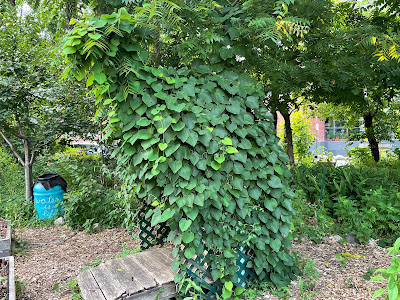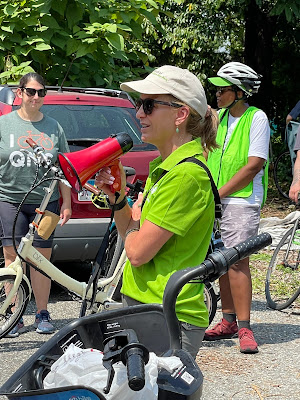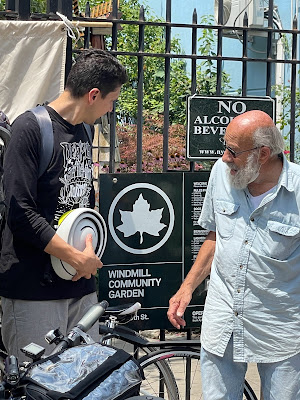This weekend I took a bike ride. That is not an unusual event but in this case it was a bike tour of community gardens. It was called a Queens waterfront garden tour because of the proximity of the gardens to the waterfront. This day, July 16, 2022 also happened to be City of Water Day in NYC and many events were scheduled throughout the city to highlight the 578 miles of waterfront and the rivers, lakes and ocean that can be found within and bordering the city. Three of the 4 gardens we visited were less than 1000 feet from the closest body of water, although actual access to the water was non existent or treacherous. A number of folks in attendance have been promoting the idea of providing public access to the waterfront, maybe not for swimming but definitely for kayaking or canoeing or for strolling along waterfront esplanades. This day I was able to combine three of my passions: bicycling, gardening and getting onto the water.
My day started early as getting from my home on Staten Island to northwest Queens required biking, taking a ferry and then riding over the Brooklyn Bridge and then an additional 6 miles following bike lanes around the Brooklyn Navy Yard, through the Williamsburg and Greenpoint waterfronts and over the Pulaski bridge into Queens. I would estimate that almost 90 percent of the ride was on protected or separated bike lanes. At least in these areas, NYC has done a good job of providing bike infrastructure.
My destination was Smiling Hogshead Ranch Community Garden where the tour would start. It seems that when the gardeners were first clearing the site they unearthed a pig skeleton which inspired the name. This site is located on top of railroad tracks which surface at points in the garden. The area was a major industrial location for many years. I was quite amazed by how beautiful the garden looked as I had originally seen it not long after the pig skeleton was found amid the weeds, trash and highly compacted soil 11 years ago. I cheekily called it the Low Line - a Queens bargain version of the multimillion dollar Manhattan High Line.
There were banana trees that one gardener told me come back year after year and were interplanted with rose bushes - maybe not a usual companion planting. I also found fig trees, a pawpaw tree and grapes which some of the children were sampling as they stood on the picnic tables to be able to reach the fruit. There was a large vine trained into a topiary animal with shaded seating underneath.
One garden bed was filled with prickly pear cactus and there was enough swiss chard ready for harvesting to feed hundreds of people. Several Elderberry shrubs were flowering and another gardener pointed out that a raised bed had been fashioned by weaving elderberry branches together. The bed was full of shiso (Perilla frutescens) plants and elderberry leaves were sprouting from the woven branches.
Several rainwater capture systems were scattered around the site. Capturing and utilizing rainwater is an important component of protecting the waters surrounding the city. Gardener Gil Lopez told me they could use a larger capture area and larger opaque tank in addition to the smaller systems they had cobbled together.
They just might get that and other support as the local Councilwoman Julie Won and the NYC Parks Commissioner Sue Donoghue took part in the ride. In fact the Commissioner visited all 4 of the gardens and we passed through or alongside several parks that are included in her domain along the ride. The GreenThumb Director Carlos Martinez also completed the entire ride. Carlos has been a long time supporter of rainwater harvesting in community gardens. GreenThumb staff did a great job of leading the tour and keeping everyone safe.
Smiling Hogshead Ranch is located on long defunct railroad tracks that were part of the industrial workings of this area. If you could head west following these tracks they eventually cross over the Dutch Kills close to where it meets Newtown Creek. This would have been the route the industrial materials and products would move in and out of this area to the rest of New York City and the nation. Our bike ride headed east following the hidden tracks to the next stop on the tour, The Long Island City Roots / Firefighter Michael E. Brennan Memorial Garden.
Over the years I have spent a considerable amount of time working at this site also built on top of the railroad tracks. While working at GrowNYC, I wrote and received an EPA grant that paid for the installation of a shade structure and rainwater harvesting system which was built during the summer of 2006. As any good garden structure, it has several uses including as a seating area for meeting, having lunch or resting from a bike ride. In 2013 I also assisted in expanding the garden westward with a deck area, raised beds for growing vegetables, a composting area and a location for beehives.
Over the years I worked very closely with gardener Noah Kaufman coordinating the projects. Noah welcomed the bike riders and gave remarks detailing the industrial and gardening history of the site. In addition to the vegetable area, the garden has a lawn area, several patio / seating areas and extensive ornamental plantings including a beautiful trumpet vine. The garden is literally a 200 foot stones throw to the end of the Dutch Kills. There is room for a plaza and a kayak / canoe launch site here which Noah and others are advocating to be built.
They also have a rainwater collection system installed in 2020 highlighting the importance of community gardens in helping mitigate the effects of storms on the city waste treatment system. Though small, the garden has a mix of ornamental and edible plantings including purple coneflower, Japanese maple trees, birch trees and roses. At one point a cucumber was harvested and given to one of the riders.
The last leg of our ride brought us to the Two Coves Community Garden, a large site where several streets form a large triangle intersection. The garden has asphalt paved paths, numerous seating areas, plantings of all kinds and an extensive composting operation. Several gardeners welcomed the riders with applause as we completed our 4 mile bicycling marathon. The garden is within 800 feet of the waterfront and also very close to Astoria Houses public housing and is well used by the community.














